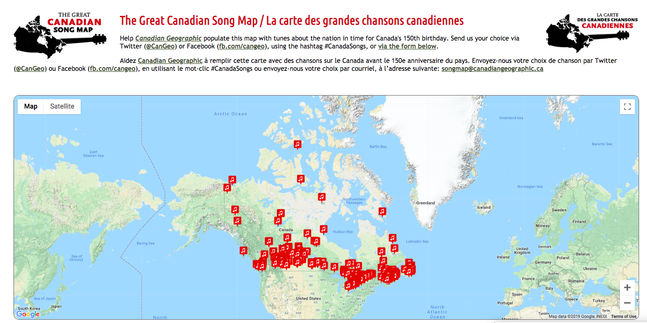https://www.youtube.com/watch?v=iW6wUYmwf_k
Kitsikakomimm (Blackfoot Love Song) - Olivia Tailfeathers
Kitsikakomimm (Blackfoot Love Song) - Olivia Tailfeathers
A Sense of Land through song:
An introduction inspired by: Canada National Geographic has created an interactive “Song” map of Canada. As well as CBC’s Canada Sound
An introduction inspired by: Canada National Geographic has created an interactive “Song” map of Canada. As well as CBC’s Canada Sound
Introduction:
The students were introduced to the geography of Canada through mystery songs.
Compare songs from different regions of Canada and start to develop an understanding that there are different Geographical Regions of Canada.
The students were introduced to the geography of Canada through mystery songs.
- In google maps, zoom into the location of a song. Listen to a song. Without zooming out, have the students tell you where they think they are in Canada (based on their inferences of what they see and have heard). (This will lead to discussion as the students say things like, “I think we are in Quebec because the lake on the map is called lac”).
Compare songs from different regions of Canada and start to develop an understanding that there are different Geographical Regions of Canada.
- Play a song that represents an area of Canada. Do not show where the song is from. Tell the students and direct them to write the song name, title, an image and description of the song (This inspires discussion and debate around the song and location as students try to figure out the location it is from, from hints of the song).
Traditional Inuit Music:
In the lesson’s below I tried to share traditional language or music being sung today. There are many bands who are singing modern music in all styles; as well as, very famous ones who have led the way for the following bands. You can find a list of examples in the resources section.
Connect the Traditional Music to a Region of Canada: Inuit Throat Singing of the Arctic:
For throat singing, be aware that kids could feel uncomfortable at the unusual sounds so you could do a lesson on how music is made with voices exclusively - first looking at modern beat boxing and pointing out the peculiar sounds that end up making a really cool beat/song. (example of Beatboxing).
Next connect it to indigenous singing and how they use their voices & show the students the video of traditional indigenous songs (example of Inuit Throat Singing).
Listen to the song from the Jerry Cans A Canadian band from Iqaluit, Nunavut.
1st. Song The Jerry Cans- The Northern Lights
2nd. Song The Jerry Cans- Ukiuq
Students work in groups of 3 to discuss what the musicians are trying to tell us. Give students discussion/ guiding questions and a piece of chart paper to represent their ideas on:
- Why do artists create these types of song? What’s the purpose?
- What does it mean to be creative? ..innovative? Artist talks about combining beatboxing with throat singing
- Your perspective: Should traditional songs, like Throat Singing, still be listened to today? Explain why/why not.
- Your perspective: Is mixing traditional music from the past with today’s music creative?
Students finish their discussion and recorded their ideas.“Geography isn’t just about places on a map; it’s about the people, culture, history and landscape of those places”.
Study different region of Canada musicians and artist. Consider:
- How do you think this music has been inspired?
- How does it connect to a region of Canada?
- How does it connect to our culture today?
- How did this song make you feel? What is the mood of the song?
- Does the song make you aware of something you did not know before? What is it?
- What is/are the most important word(s) in the song? Why?
- What are some things that are puzzling to you about this song?
- Where and when was the song written?
- What was the purpose of the song?
- Is there a message the song is trying to convey? If so, what? To whom?
POW WOW SINGING AND DRUMMING OF THE PLAINS
Pow Wow music can be heard and is celebrated across Canada.
INTRODUCTION:
1. Listen to pow wow drumming, such as:
The Bounce by Northern Cree Singers https://www.youtube.com/watch?v=Ry5eQC6bYOM)
Or (Sing from the Heart by the Ottawa River Band https://www.youtube.com/watch?v=5RvN95qI6BQ)
2. Students research Pow Wows and have discussions around the traditional celebration. Work in partners to become knowledgeable about Pow Wows. Use the questions below to guide them:
Guiding Questions:
- What do you see and hear?
- Why are Pow Wows held?
- Who attends Pow Wows?
- Are there different Pow Wows for different Indigenous Nations? Such as the Siksika, Kainai, Piikani, Stoney-Nakoda, and Tsuut'ina nations?
- When was the last Pow Wow?
- Where do Pow Wows happen?
- Is there a Pow Wow that I can go to?
A few websites that may be helpful:
- http://www.thecanadianencyclopedia.ca/en/article/powwow/
- http://www.thecanadianencyclopedia.ca/en/article/powwowmusic/
- https://christophermartinphotography.com/tag/pow-wow/
EXTENSION: Students could pick one thing their family celebrates and create a guide for a person who has never heard of that celebration before. Such as this one (http://www.cbc.ca/parents/learning/view/powwow-guide)
